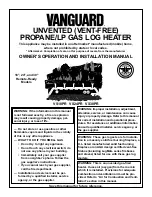
INSTOMAX
TM
Integrated instantaneous water heater installation, use and care manual
(Revision Sept 2013)
,
Page
4.
Section 3: INSTALLATION
The manufacturer’s warranty does not cover
any damage or defect caused by installation
or attachment or use of any special
attachment other than those authorized by
the
manufacturer
into,
onto,
or
in
conjunction with the water heater. The use of
such unauthorized devices may shorten the
life of the water heater and may endanger life
and property. The manufacturer disclaims
any responsibility for such loss or injury
resulting from the use of such unauthorized
devices.
3.1 SAFETY MEASURES
All domestic and commercial installations will
include a pressure relief valve limiting the
operating pressure to 207 kPa (30 psi) for the
INSTOMAX’s reservoir.
This INSTOMAX™ electric water heater is
designed for a maximum operating temperature
of 88°C (190°F). Typically, the tank’s thermal
mass liquid is tap water. If allowed by local
authorities and applicable code, a 30 to 50%
water and propylene-glycol blend can be used
for installation where supply fresh water
pressure is above 240 kPa (35 psig). Specific
equipment designed to avoid backflow to the
main water supply network might be required by
local installation codes.
3.2 EMPLACEMENT
The INSTOMAX™ water heater should be
installed in a clean, dry location. Long hot water
lines should be insulated to conserve water and
energy. The water heater and water piping
should be protected from exposure to freezing.
INSTOMAX™
water heaters must be installed
vertically. Use the adjustable feet to level the
unit.
The INSTOMAX
TM
water heater must be located
or protected so as not to be subject to physical
damage, for example, by moving vehicles, area
flooding, etc..
All models can be installed on combustible floors
and in alcoves. If the water heater is to be
installed in a restaurant or other location where
the floor is frequently cleaned, it must be
elevated to provide at least 150mm (6 inches) of
clearance from the floor to comply with NSF
International recommendations.
The room temperature must be maintained
between 10C (50F) and 33°C (90°F).
3.3 CLEARANCES
Minimum clearances required for inspection and
servicing are:
Tableau 4: Minimum clearances
Left side 0mm (0 in.)
Right side
0mm (0 in.)
Top 100mm (4 in.)
Front 400mm (16in)
Back
0mm (0 in.)
3.4 SYSTEM SETUP
Figures 1,2,3 illustrate components location and
a typical basic piping diagram. Additional
outboard mounted components may be required
in order to allow special application or local
codes
and
authorities
having
jurisdiction
requirements.
3.5
PIPING
(see
figures
1&2
for
identification and locations of components)
3.5.1 Tank pressure relief valve
The tank is protected with a pressure relief valve
set at 207 KPa (30 psig). NEVER replace this
pressure relief valve by a higher set pressure
one. Connect the supplied relief valve outlet
downward to insure that any expel water will be
directed toward a safe location. NEVER plug
the relief valve.
Piping diameter must not be smaller than the
pressure relief valve . The end of the piping
must be visible and not exposed to freezing.
3.5.2 Operating pressure control:
expansion tank:
The water heater is provided with a combination
pressure regulator / check valve allowing the
filling and pressurisation of the tank. The initial
pressure is generally of 83 kPa (12 psig).
In operation, water expansion will increase the
internal
INSTOMAX™,
pressure.
Typical
operating pressure should be between 83 and
190 kPa (12 and 28psig) according to the tank
temperature.
WARNING
!






























